
23 Jan, 2017
ASEAN@50: Singapore disappoints with lacklustre Tourism Forum
Singapore — ASEAN tourism is one of the world’s great, if not the greatest, success stories. As the 10-country bloc marks its 50th anniversary, tourism is clearly established as a bedrock industry that has created billions of dollars worth of prosperity, jobs and income. The former battlefields of Laos, Cambodia and Vietnam have emerged from war, communism and genocide to become tourism and trading fields. Myanmar has come in from the cold. Borders are opening up, low-cost airlines and highways criss-cross the region. Creative and visionary public-private sector executives have developed award-winning hotels, airports, convention centres and shopping complexes, with more coming up.
All this was made possible by people with dedication, focus and commitment who fought to change policies, eliminate restrictions, promote investments, develop the right products and create vibrant marketing campaigns. In total, an inspiring collection of stories well worthy of global recognition, tribute and appreciation.
If anyone was expecting the ASEAN Tourism Forum held here between 16-20 January to flag the pride and respect this rich history and heritage deserves, they were in for a disappointment. It turned out to be just another routine travel trade show.
The Singaporean Prime Minister delivered another matter-of-fact speech in which he called ASEAN a “life-raft”. In fact, it is much more than that; it is the life-blood of the people, especially Singaporeans who thrive on the life-sustaining opportunities offered by the region as a whole. The ASEAN tourism ministers produced another one of their repetitive media statements that voiced no appreciation for the enormous work done by their predecessors. The ASEAN Tourism Conference, organised by the National Association of Travel Agents of Singapore and the Singapore Hotel Association, was just another rehashed event focussing on regional hotel performance and the impact of technology, topics beaten to death at dozens of industry conferences.
Paying tribute to the decades of progress was in fact the compelling order of what could, and should, have been an extraordinary ATF. The event marked the second year of ASEAN integration, the 50th anniversary of ASEAN and the completion of the auspicious third 12-year cycle of the ATF itself. The confluence presented an ideal opportunity for ASEAN tourism to take stock of the past, weigh its strengths and weaknesses, evaluate what has been done right and perhaps not so right, reap the opportunities and provide some realistic perspectives of the future. It was also ideal time to remind all industry stakeholders of the core mission and vision statement of the ASEAN leaders viz., to build One Vision, One Identity, One Community.
The Singapore ATF did none of the above.
It was, indeed, just another routine travel trade show.
When Jesper Palmqvist, Area Director of STR, an hotels data tracking company, opened the ASEAN Tourism Conference, he began with a slide that had just one word on it: UNCERTAINTY. He cited the Brexit vote, the South China Sea disputes, the banking crisis, the economic slowdown in China and the Indian demonetisation, along with potential health threats such as the Zika virus as factors that are impacting global travel in different parts of the world. He then showed the following slide as being another potential danger zone.

Several other factors went unmentioned. In the same week as the ATF, the World Economic Forum was under way in Davos. There, another set of potential disruptions was highlighted – the loss of global trust in leadership and the crisis of capitalism. Oxfam issued a report flagging the instability risks of global inequality. The International Trade Union Confederation issued a damning report on the global jobs crisis. And the United Nations issued a report saying that 2016 was the hottest on record.
None of that seems to matter to a surging ASEAN tourism sector. This, thanks to the Chinese. In their media presentations at the ATF, all the ASEAN NTOs reported that China was generating huge growth. It is already the top source market for Thailand, the second largest source-market for Cambodia and the fastest growing market for Indonesia. In the next two-three years, China will be at the top of the league for all ASEAN countries. Other populous source-markets are set to follow. India is waiting in the wings, Russia is making a strong comeback and the intra-ASEAN market is in the same neighbourhood.
From a bottom-line perspective, ASEAN tourism is an apparently bottom-less pit, impervious to global and geopolitical threats. It is even bucking its own national image problems. The Philippines is getting considerable bad publicity because its tough-guy President Duterte is admitting to drug killings. No problem. The country has settled its border problems with China and tourism is up. Myanmar is getting bad publicity due to its government’s persecution of the Muslim Rohingyas. No problem. The sanctions are gone, and people are heading for the country in droves. Thailand is under a military dictatorship that is becoming increasingly draconian. No problem. It has enjoyed record breaking arrivals of 32 million and now leads the ASEAN countries in terms of arrivals.
Even Brunei is being forced by the decline in global oil prices to get serious about promoting tourism in a more professional manner as part of its overall agenda to develop the non-hydrocarbon economy.
This has opened up some new challenges. Clearly the era of generating growth has been replaced by the era of managing growth. The doors of intra-ASEAN accessibility and facilitation are now wide open thanks to the ASEAN visa-free and open-sky agreements. Travel flows are set to become a flood. And flooding is dangerous. It is already creating severe management problems at popular tourist attractions and destinations, ranging from carrying capacity issues to garbage generation, crime, safety and security, water consumption, law enforcement and more.
And it’s going to get worse.
If the ASEAN Tourism Ministers media statement and the ASEAN tourism conference is any indicator, none of this warranted a discussion. In fact, the ASEAN tourism fraternity wants to open the floodgates even more, with more marketing plans.

Neither does tourism seem to be interested in contributing to that other vital component of the ASEAN integrated community, the Socio-Cultural Blueprint, and the role of tourism in building One Vision, One Identity, One Community. In October 2016, the ASEAN secretariat issued a superb report “ASEAN Strategic Plan for Culture and Arts 2016-2025”. This is what it said in the preamble:
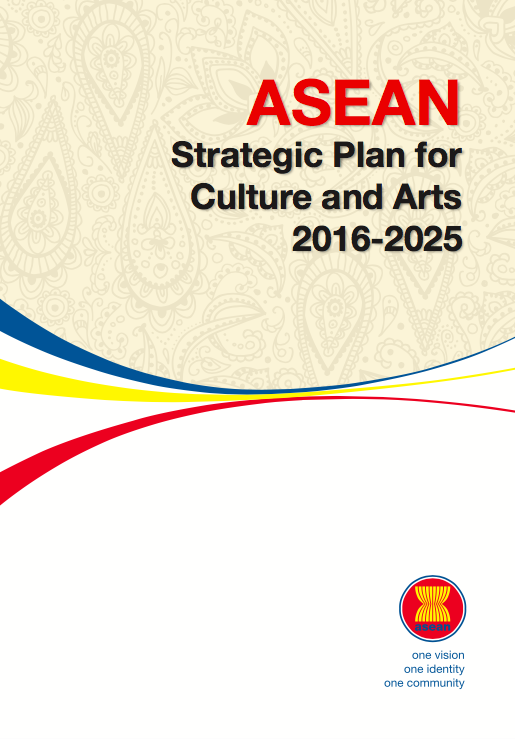 |
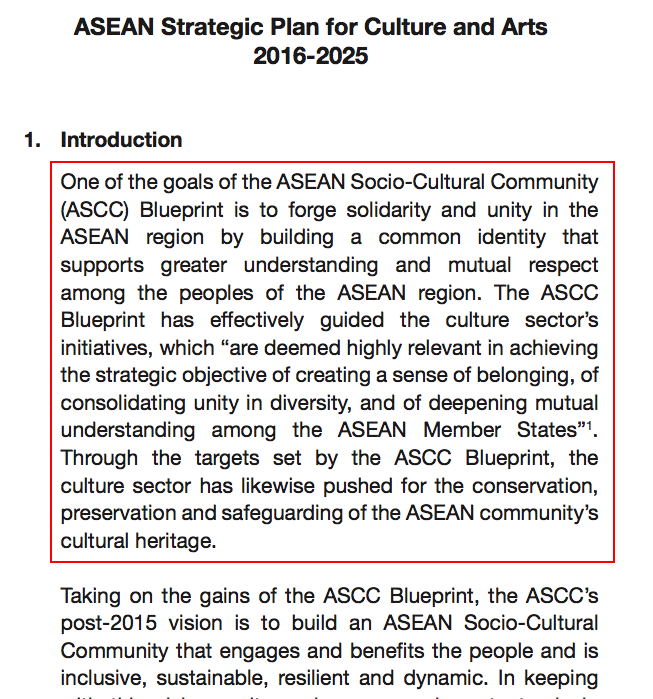 |
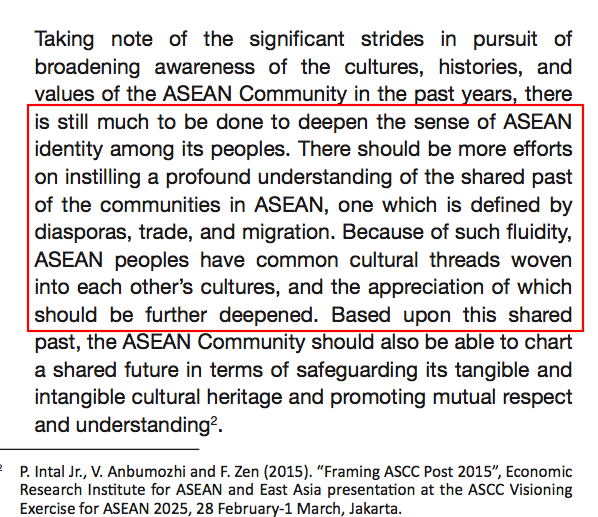 |
Unfortunately, the entire report makes only one direct reference to tourism.
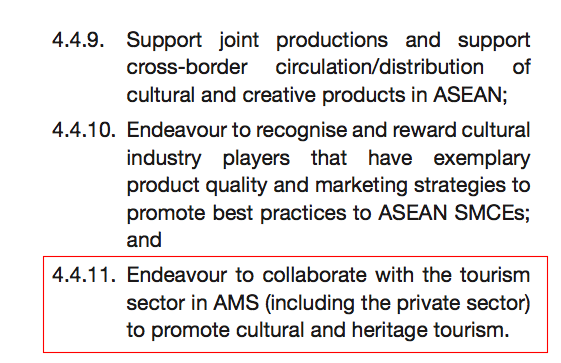 |
And tourism repays the compliment. The ASEAN tourism ministerial meeting made only one reference to culture.
This ASEAN blind spot about the strong tourism-cultural linkages is even more puzzling when it is noted that three ASEAN countries (Vietnam, Laos, Malaysia) have ministries that combine the portfolios of tourism and culture. Moreover, Singapore itself has some of the best museums in ASEAN saluting the historic diversity, culture and heritage of its vast Asia-Pacific hinterland.
The 50th anniversary of ASEAN was the perfect opportunity to put all these issues on the table. An entire conference could have been organised around them. ASEAN tourism veterans could have been flown in to reminisce and reflect, offer advice and guidance. A commemorative book could have been produced. There could have been banners, posters, giveaways. No such luck. Apart from an ASEAN Travel & Tourism Hall of Fame launched by this editor, and a 50th anniversary publication produced by TTG, there was little or no commemoration of the past.
At the doing-business level, some changes were apparent but produced mixed results.
The Travex sessions proved productive. Sellers were generally happy with the quality of buyers, especially the many new faces in the line-up. They also gave a thumbs-up to the high-tech appointment scheduling system. All the buyer-seller badges had QR codes which could be scanned for full details to be entered into their respective mobile phones. That saved a lot of time, although many others preferred to do it the old fashioned way with name-cards and diaries. The app-based system also made it easy to change or cancel appointments, and insert other appointments in lieu. This editor found no-one complaining about it.
Buyers were required to show proof of having fulfilled a minimum of 32 appointments to pick up their air-fare reimbursements on the afternoon of the third day. Most of them filled their slots in the first two days, with the result that the third day there were a lot of no-shows, especially around the reimbursement time. In turn, several buyers complained about the absence of hosted lunches.
On the flip side, the media management left much to be desired. The no-frills, low-cost media centre had no press kits. As there were no hosted lunches or coffee-breaks, networking opportunities fell short. In addition to the main event, all media, both hosted and non-hosted, had to register for the opening and closing ceremonies and the ministerial press conference. They then had to queue up to get wristbands to gain entry to the events. Buyers and sellers had to do the same for the opening ceremony. This led to time-wasting queues like this:
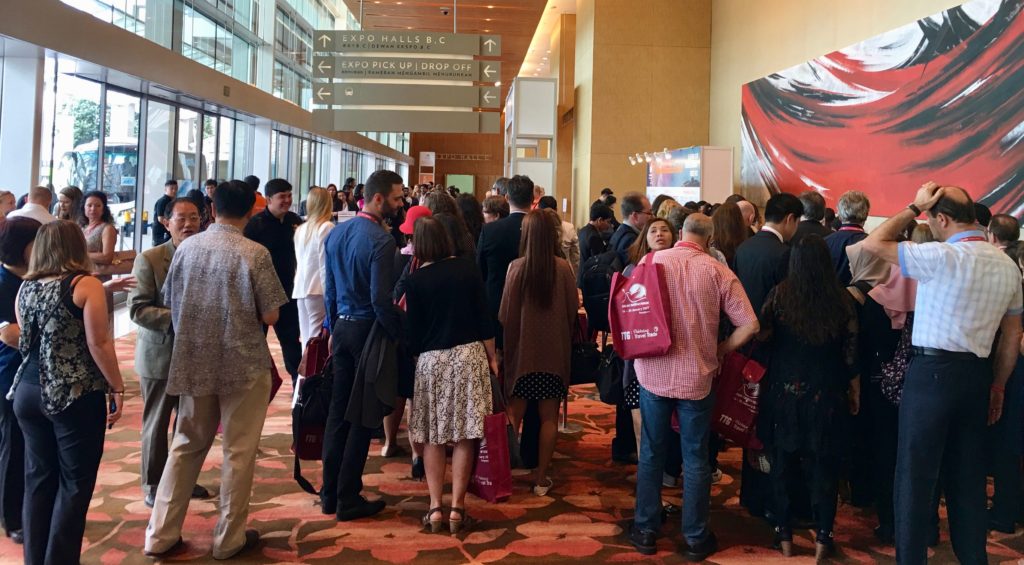
This multiple registration process was new to the ATF, and made no sense. Registration has always been a one-stop shop. The badges suffice for everyone to get access to public events, with specific invitations included in the kits. Not aware of this new procedure, nor familiar with the app-based information-dissemination process, I missed the pre-registration requirement. The Singaporeans, as always stickler for the rules, enforced it to the hilt. For the first time in my 30 years of covering ATF, I did not get access to the opening and closing ceremonies, nor the ministerial press conference. Fortunately, the Thai night was typically Thai, relaxed, elegant and free of pre-registration hassles.
If the Singapore ATF ignored the past, it certainly kept a strong focus on the future. In addition to the roster of VisitASEAN@50 events and activities, a promising future lies in cruising, which benefits all ASEAN countries, even landlocked Laos if river-cruising is included. This is what the ministerial media statement had to say about the cruise sector.
 |
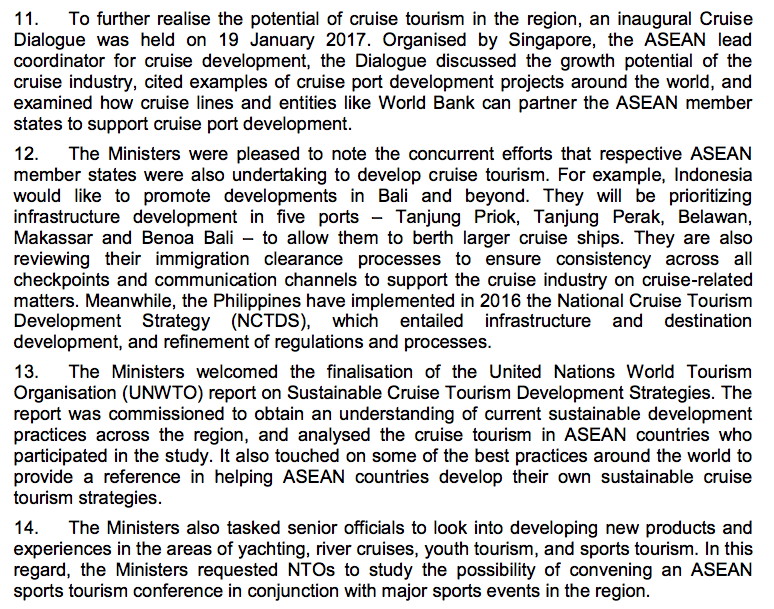 |
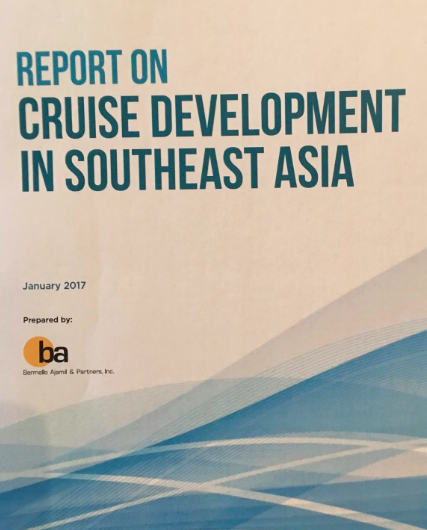 |
If the requisite infrastructure is fixed, cruising will generate another few million visitors. That will only up the pressure for a far more important future infrastructure requirement — the need for a total revamp of ASEAN tourism structures, processes, funding and agenda to cope with the Age of Uncertainty. In fact, parts of the ASEAN Tourism Strategic Plan 2016-25 have already been rendered irrelevant by the phenomenal disruptions and changes of 2016, the very first year of the plan.
ASEAN tourism may have a dream of marketing itself as a single destination. But it has no single leadership, nor a single spokesperson. Tourism is just one cog in a big ASEAN wheel. The secretariat is just that, a glorified secretary responsible for shuffling paper, compiling reports and taking orders. It is excessively dependent on external consultants and funding sources. The secretariat does not give media briefings, nor provide independent thinking nor analysis. It just does as it is told.
The private-sector ASEAN Tourism Association is a shadow of its former self. The ASEAN national airlines have zero interest; not a single one had a booth at the ATF 2017, not even Singapore Airlines, even though it was listed as one of the event sponsors.
In 2018, the ATF will be held in Thailand which should allow the organisational aspects to go back to “normal.” The Thais will no doubt deliver the robust hospitality they are well-known for. As the geographical hub of ASEAN and host to both the PATA HQ and the entire Asia-Pacific command of the United Nations system, Thailand has a unique opportunity to deliver a holistic, comprehensive ATF 2018. The Chiang Mai venue will also allow visitors to experience the soul-searching wisdom of the Royal Projects initiated by the late King, His Majesty Bhumibhol Adulyadej and the rustic beauty of the northern Thai border-sharing countries of Myanmar and Laos.
The theme of the Singapore ATF was “Shaping Our Tourism Journey Together.” It failed to do that on many fronts. The Thais won’t make that mistake.



Liked this article? Share it!